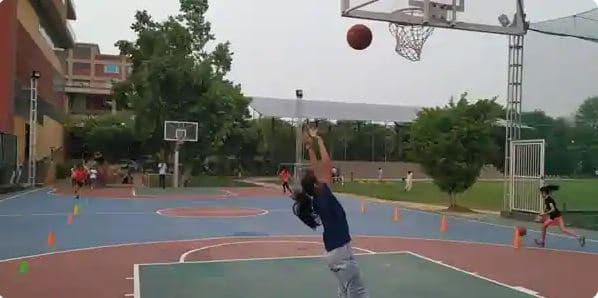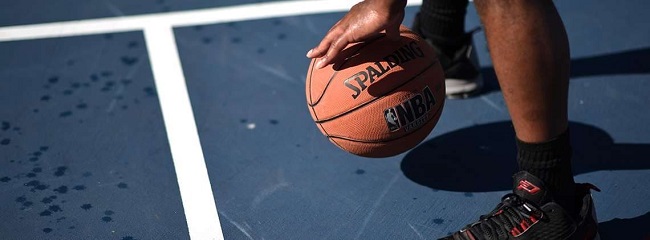From NBA basketball to the Olympic games to pick-up games at the local gym, basketball is a popular sport able to be played at multiple skill levels. Check The 16 Common Rules In Basketball.
Like all sports, basketball has a unique set of rules that establish guidelines for personnel, penalties, and gameplay.
Dr. James Naismith invented the game of basketball in Springfield, Massachusetts, in 1891. The objective of today’s game stems directly from Naismith’s original rules.
These rules are based on shooting a ball through a metal hoop suspended above the ground, which is called a basket. Check out the rules of basketball.

The 16 Common Rules In Basketball
The 16 Common Rules In Basketball See Below Details.
1. Only five players per team on the court
In the NBA, WNBA, and NCAA basketball, each team can play a maximum number of five players on the court. If a team breaks this main rule, they will lose possession of the ball. Sometimes this inadvertently happens, particularly at low levels of the game, when substitute players check into the game and others don’t leave the court in time.
2. Score more than your opponent to win
To win the game, a team must score more field goals than the other team. A field goal refers to any basket a player scores during gameplay. Field goals can be worth two or three points. They are shot from inside the arc that designates the three-point line on the court is worth two points. Field goals shot from outside the arc are worth three points. Field goals can take the form of jump shots, layups, slam dunks, and tip-ins.
3. Score within the shot clock
Teams have a limited amount of time to shoot the ball during a given possession. In the NBA and WNBA, teams are allowed 24 seconds of possession before they must shoot, while NCAA teams are allowed 30 seconds. A shot clock mounted above the hoop on each side of the court displays and counts down the time allotted. If the shot clock elapses, the opposing team forfeits the ball and becomes the defensive team.
4. Dribbling advances the ball
Basketball players may only advance the ball by passing or dribbling (bouncing the ball on the floor) as they move up and down the court. If a player stops dribbling, they may not resume; instead, they must pass the ball or shoot it.
If an offensive player with possession of the ball stops then continues dribbling before passing or shooting, the referee will call a “double dribble,” and the opposing team gets the ball. Additionally, players may only advance the ball by dribbling it. If they run while holding the ball, they are traveling. Referees will issue a traveling call, and possession of the ball will go to the opposing team.
5. The offense has five seconds to inbound the ball
After the offense scores a basket, the opposing team receives possession of the ball. One of their players has to inbound the ball from a designated spot on the sidelines of the court to resume gameplay.
The player has five seconds to pass the ball to another player on his team, or else the team loses possession. The defender cannot contact the ball when the offensive player is trying to inbound it, or the referee can issue a technical foul.
6. The offense must advance the ball
Once an offensive team advances the ball past the half-court line, the ballhandler may not cross that line again, or a referee will award possession of the ball to the opposing team.
7. Ball and ballhandler must remain inbounds.
During gameplay, the player with possession of the ball must stay within the designated inbounds lines marked on the court. If a player steps out of bounds or touches this line with their foot while holding the ball, the referee will award possession to the opposing team. Additionally, if a player shoots the ball while their foot is touching the line and the shot is successful, it will not count.
8. Defenders can’t interfere with a shot on a downward trajectory
After the offensive player shoots the ball, it is illegal for a defensive player to interfere with it once it begins its descent toward the rim. This interference is called a goaltend and will result in an automatic field goal for the offense.
9. Defenders can legally block or steal the ball
The defending team’s goal is to prevent the offensive team from scoring by either stealing the ball, blocking the ball from entering the basket, or using defensive tactics to prevent an offensive player from shooting and scoring.
10. Defenders must leave the paint after three seconds
The area directly in front of the basket is sometimes referred to as “the paint” or “inside the key.” Offensive players may not camp out in this area waiting for the ball or an offensive rebound. Any individual player can spend a maximum of three seconds at a time in the space before they have to move. Once they step out of the paint, they can return. If the referee notices a player hovering in the paint for over three seconds, the team will receive a three-second violation.
11. Each team is allotted a certain number of fouls
The NBA allows each team a total of five fouls per quarter. Once a team surpasses this allotment, they go “into the bonus,” which means the officials will award the opposing team with free throws for every additional foul that a player commits in that quarter of play.
In the NCAA, these foul shots are known as “one and one” shots, which means that if a player makes the first free throw, they receive a second free throw. If they miss the first free throw, either team can rebound the errant shot and claim possession. After 10 team fouls, the opposing team gets a “double bonus,” which means they get to take two foul shots.
12. Illegal contact results in a foul
When a basketball player commits illegal physical contact against an opposing player, the referees will call a personal foul. Most player fouls involve contact that impedes an opposing player’s gameplay.
When a player fouls another player on an opposing team in the act of shooting, the referee rewards the fouled player with unguarded free throws from the foul line. Each successfully made free throw counts for one point. Referees can assess coaches with fouls for unsportsmanlike acts, such as using profanity to dispute a missed call.
13. Illegal contact results in a personal foul
A personal foul is an infraction that violates the rules of the game. Players can incur personal fouls by pushing, blocking, or striking another player in the act of shooting. Shooting fouls result in free throw attempts for the fouled player.
If a defender fouls a shooter attempting a two-point shot, the shooter will receive two free throws. When a shooter is fouled during a three-point shot attempt, they will receive three free throws. If the player makes the shot they were attempting at the time of illegal contact, the basket counts, and the shooter will receive one free throw.
14. Excessive contact results in a flagrant foul
Flagrant fouls refer to a personal foul that can potentially injure the opponent. These fouls carry heavier penalties, such as fines, immediate ejection, and even suspension. There are two types of flagrant fouls: flagrant foul—penalty 1 and 2.
Flagrant 1 refers to fouls involving unnecessary contact. The penalty for this foul type is a free throw for the opponent and possession of the ball. Flagrant 2 refers to any foul involving unnecessary and excessive contact. Officials perform an instant-play review to determine if an activity qualifies for the flagrant 2 penalties. If it does, the player at fault has assessed a fine and an automatic ejection from the game, and the opposing team receives free throws and possession of the ball.
15. Charges and illegal screens result in an offensive foul
An offensive foul is a personal foul that offensive players commit when their team possesses the ball. The two most common offensive fouls are charging and illegal ball screens.
Charging is when an offensive player makes contact with a defensive player who has planted their feet in a locked position. An illegal screen is when a non-ball-handling offensive player moves while setting a screen for their teammate to prevent the defender from moving about the court.
16. Certain rule violations result in technical fouls
A technical foul is a penalty for violating the game’s administrative rules. Officials commonly assess technical fouls for fighting and verbal abuse, often assessing coaches with this penalty if they are too abrasive when disputing a call.
Technical fouls result in a free throw and a change of possession. If a player or coach receives two technical fouls in the same game, the referee will eject them. Players with a long history of technical fouls risk suspension from the regular season and even playoff games.

